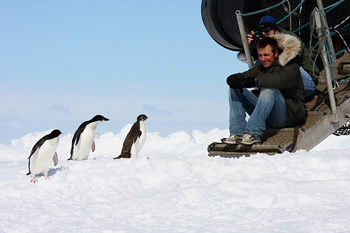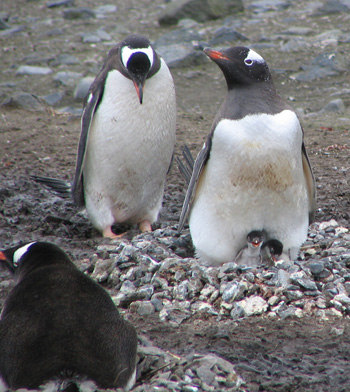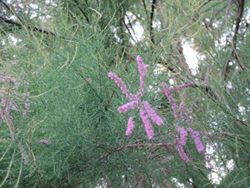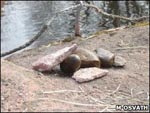- All News
-
- Grad Student News
- Outreach News
- Search News
- Science Fun Facts
- Social Media
- Archived News
- Newsletters
- Expert Insights: Ben Hess on Importing Biological Materials
- U-M Herbarium Publication Spotlight: Dr. Thaís Vasconcelos and Dr. Aly Baumgartner Collaborate on Paper in New Phytologist
- U-M Museum of Zoology Publication Spotlight: Dr. Benjamin Winger's Study on Songbirds
- UMMZ Spotlight: Charlie Engelman Named to TIME’s "100 Most Influential Creators of 2025"
- Herbarium Spotlight: How AI is Transforming Specimen Transcription
- UMMZ Spotlight: A’liya Spinner is helping preserve the future of bees
- Meet the Researchers Driving Discovery Through the Biodiversity Exploration Fund
- EEB and U-M Museum of Natural History Celebrate ID Day
- All Events
Click the + to read more.
Send your fun fact idea to eeb-webinfo@umich.edu.
Is dirt "alive?"
Dirt will keep organizing itself into clumps and copying itself in different parts of nature all around the world. Not just dirt, but other things without cells, do the same thing—including snowflakes, animal shells, languages, and social cultures. Can you think of something else without cells that looks like it’s alive?
The invisible roles of color
We all know that nature is full of beautiful colors, amazing patterns, and incredible forms of camouflage – but what other functions do colors serve when they aren’t helping an animal hide or show off? In reptiles, and other ectothermic (“cold-blooded”) animals, certain colors can actually help them warm up in cooler temperatures.
What we eat plays a huge role in climate change
Everyone knows that climate change is going to have major effects on the way we live our daily lives, but have you ever thought about if it will change how we eat? Agriculture is the number three emitter of carbon into the atmosphere. There is a trend of deforestation that is attached to agricultural land unlike what we have ever seen throughout the history of humankind.
Birds and bees look very different, and so do their sperm!
Regardless of whether you’ve taken a sex education course or not, you’ve probably never seen a picture of a sperm cell from any animal other than humans. Well, luckily for you, that’s about to change today!
But first, what are sperm? Most cells that make up your body have specific functions, and sperm are no exception. Sperm cells function solely in reproduction (that is, for making babies).
So many dewlaps, so little time
If you come across a slender green or brown lizard in the eastern United States, chances are you’re looking at a species known as the green anole (unless you’re in Florida, where you could be looking at just about anything). Observe this lizard for a bit, and you might see it do some pushups and flash a bright pink throat fan at you. What is going on here? What could this lizard possibly be trying to tell you?
Bats and diseases, what’s the deal?
A lot of people think bats carry a lot of diseases, but is it true? The answer might surprise you.
Bats, like humans, are mammals. This means it’s easy for diseases to pass between us since we’re pretty similar. Bats nurse their young, have fur (yes, your hair is fur), and can maintain a body temperature warmer than their surrounding environment.
Hairy plants?!
You’ve probably noticed that different types of plants have different types of leaves, but did you know that some of these leaves can grow their own version of hairs? In plants, we refer to these small external hair-like structures that grow on the plants’ surface as trichomes.
What's in a name?
Did you know that when scientists discover and describe new species, they are allowed to name them? Often, they will name them after other scientists they admire.
Amazing algae
You may have heard of algae (or seaweed) because it turns your fish tank green or you eat it when you eat sushi. However, there are thousands of species of algae that all have different ecological roles, and they can look completely different from what you might expect!
Wasp University
When we think of intelligent behavior we usually think of humans, primates, dolphins, elephants or other animals that are traditionally viewed as “smart.” But, what does it really mean to be smart?
Birds (and dinos) of a feather
“Science tells us that birds are living dinosaurs,” said Dan Rabosky, University of Michigan professor of ecology and evolutionary biology and curator, Museum of Zoology. Did you know that dinosaurs and birds are reptiles?
Snowy owls don't need fuzzy slippers
Snowy owls don’t have to put on snow pants or fuzzy slippers to stay warm even in the winter winds in cold Arctic regions because their legs and feet are covered with feathers.
A1 coral reef fertilizer
Q: What makes coral reefs healthy?
A: Fish pee (or in Haitian Creole pipi pwason)!
MIGHTY MITES
Mites in space
Mites are the first animal space hitchhikers. A colony of the mold mite (Tyrophagus) has been found inside the International Space station. On Earth, this mite is common in houses and stored food.
Ocean weather report: blizzard -- every day!
Every day a steady blizzard of marine snow rains about two million tons of carbon to the floor of the deep blue sea. “It’s really beautiful,” said Melissa Duhaime, assistant professor of ecology and evolutionary biology, even though the particles are primarily “poop” and carcasses from microbes living on the ocean’s surface.
FUNgus = your new BFF?!
What's the largest organism on Earth? A blue whale? Redwood tree? Nope! A fungus. Not only that, a fungus has the fastest acceleration in nature. And -- without them -- we'd be buried miles deep in fallen leaves and logs! Don't believe it?
Why are monarchs so brightly colored?
A monarch's flashy appearance may warn predators not to mess with them.
This fish wins father of the year
Not only does the cardinalfish, Simphamia tubifer, carry its very own nightlight, the father fish carries the eggs it has fertilized until they hatch.
Why do zebras have stripes?
The mystery behind zebra’s striped pattern may be solved. Alumnus Amanda Izzo (Ph.D. EEB 2011) and researchers at the University of California Davis, published a study in Nature Communications explaining their “black and white” findings.
Watch Bald Eagles in their nest and eaglets hatching in spring!
The Decorah Bald Eagles video project began when the first camera was installed in 2009.The eagle’s next is about 80 feet high, six feet across, five feet deep and weighs close to 1,367 pounds.
Birdie boogie!
Another ability long-thought to belong solely to humans, like tool-use or counting, does in fact occur in other species, according to two new studies, published in Current Biology.
Porpoising penguins and plenty more!
Did you ever want to know more about the waddling, flightless seabirds who appear to be dressed to the nines in handsome tuxedos? Here are some fun penguin facts and amazing photos.
We're not saying those mushrooms growing in your yard are your second cousins...
Although traditionally studied by botanists, fungi are actually more closely related to animals (like you!) than plants. Animals and fungi are sister kingdoms of a “supergroup” called Opisthokonta.
Walking bats!
The recent discovery of fossils of an extinct walking bat in northwestern Queensland, Australia, suggests that today's lesser short-tailed bats descended from 20-million-year-old Australian relatives.
Have you seen this tree?
While walking around near downtown Ann Arbor, Birgit Otte of U-M’s Department of Astronomy saw the tree pictured here. She had never seen it before and wondered what it was. Her curiosity led her to write to EEB for assistance.
Chimp plans stone attacks on zoo visitors
A male chimpanzee in a Swedish zoo planned hundreds of stone-throwing attacks on zoo visitors. Keepers at Furuvik Zoo discovered that the chimp collected and stored stones that he would later launch toward onlookers.
Chimps invent brush-tipped tool
Wild African chimpanzees invented a new and improved brush-tipped tool to gather more termites to eat, according to a new study in the Royal Society Journal Biology Letters.
Diet Coke and Mentos: An explosive combination!
The "Mentos effect" occurs when a Mentos mint, the cult candy associated with dorky 1990s commercials, is dropped into cola.
An American Robin backyard mystery
This fun fact was prompted by a question from Shirley Spence in Monroe, Mich. who watched this spring as one nest full of robin’s eggs hatched and then two weeks later, to her surprise, new eggs appeared.
Picture this: You vs. the chimp
Think chimps are chumps when it comes to serious mental powers like short-term memory? A new study says that young chimpanzees can significantly outperform you at some short-term memory tasks.





